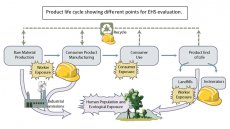Health and Safety and Environmental Issues
With the advent of new technologies, including nanotechnology, one should consider both potential benefits and unintended risks to human health and the environment that might accompany development and use of the technology. The National Nanotechnology Initiative (NNI) is committed to the responsible development of nanotechnology as one of its four main goals, and as an important part of its environmental, health, and safety (EHS) research strategy. This includes sound, scientific assessment of nanotechnology’s benefits and risks, and an understanding of the potential EHS impacts of nanotechnology.
Nanotechnology Environmental and Health Implications (NEHI) Working Group
The NNI addresses EHS issues through the Nanotechnology Environmental and Health Implications (NEHI) Working Group of the Nanoscale Science, Engineering, and Technology (NSET) Subcommittee of the National Science and Technology Council. Member agencies of the NEHI Working Group have a wide range of Federal activities and responsibilities including research and regulatory missions. Representatives from the NEHI member agencies meet regularly to discuss agency research activities, to identify areas of possible collaboration and cooperation, and to efficiently leverage Federal resources.
Federal Investments in Nanotechnology-Related EHS Research
U.S. Government funding for research dedicated to nanotechnology-related EHS (nanoEHS) grew substantially from $35 million in 2005 to about $100 million per year for 2014-2016. Cumulative EHS investments from 2006 through 2015 have now reached more than $1 billion. Nanotechnology EHS activities, including relevant topics incorporated into the Nanotechnology Signature Initiatives (NSIs), are estimated to account for nearly 10% of the NNI budget request in 2017. These investments are coordinated through the NEHI Working Group with assistance from the National Nanotechnology Coordination Office.
Developing the NNI EHS Research Strategy and Monitoring Progress
The Federal Government’s commitment to health and the environment has been part of a nanotechnology research framework since 2001. Federal agencies participating in the NNI regularly assess research progress and identify priority gaps and emerging trends through dialogue with stakeholders: academics, industry, public health advocates, and the general public. NNI agencies have incorporated these findings into its evolving EHS research strategy. In 2008, the NNI published its first formal EHS strategy. That 2008 document was updated to the current NNI EHS Research Strategy in 2011. This updated strategy included input from a wide range of stakeholder communities including academic researchers, consumer and environmental groups, manufacturers, and the general public through a series of workshops. The overall goal of the NNI EHS Research Strategy is to ensure the responsible development of nanotechnology by providing science-based guidance to the Federal agencies that produce the scientific information for risk management, regulatory decision making, product use, research planning, and public outreach. The NNI participating agencies continue to engage stakeholders through workshops and other means, to inform the ongoing implementation of the 2011 EHS Research Strategy.
In 2014, the NNI agencies examined the implementation and coordination of the 2011 EHS Research Strategy in a Progress Review on the Coordinated Implementation of the National Nanotechnology Initiative 2011 Environmental, Health, and Safety Research Strategy. The examples described in this document demonstrate the breadth of activities in all six core research areas of the 2011 NNI EHS Research Strategy carried out by Federal agencies participating in the NNI, and of the collaborative efforts that the agencies have undertaken with external stakeholders.
The Science of EHS Research
To make Federally funded nanoEHS research practical and timely, the framework underlying the 2011 nanoEHS research strategy integrates several important concepts—risk assessment, product life cycle stages, and exposure—into the basic and applied research to understand the potential EHS impacts of nanomaterials.

Nanotechnology risk assessment is a process through which these advanced materials are evaluated to better understand their potential to harm humans and the environment, combined with the likelihood that there could be any exposure to the material, including the extent and duration of that exposure.









